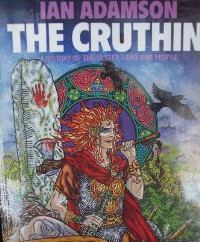Current head none | Parent house House of Ir | |
 | ||
Titles Kings of UlsterKings of TaraHigh Kings of IrelandKings of Dál nAraidiUa Loingsig of Moylinny Cadet branches Uí Echach CoboMagennis, Lords of IveaghMacCartan of Kinelarty | ||
The Cruthin (Old Irish, [ˈkɾˠʊθʲɪn̠ʲ]; Middle Irish: Cruithnig or Cruithni; Modern Irish: Cruithne [ˈkɾˠɪhn̠ʲə]) were a people of early medieval Ireland, who occupied parts of the present day counties of Antrim, Laois, Galway, Londonderry and Down. Their name is the Irish equivalent of Priteni who are more commonly known by the Latin form Picti. Despite this, a distinction was usually maintained by Irish authors writing in Latin.
Contents
The Cruthin comprised a number of túatha (territories), which included the Dál nAraidi of County Antrim and the Uí Echach Cobo in County Down. Early sources preserve a distinction between the Cruthin and the Ulaid, who gave their name to the over-kingdom, although the Dál nAraidi would later claim in their genealogies to be na fir Ulaid, meaning "the Ulaid people". The Loígis, who gave their name to County Laois in Leinster, and the Sogain of Connacht are also claimed as Cruthin in early Irish genealogies.
By 773AD, the annals stopped using the term Cruithne in favour of the term Dál nAraidi, who had secured their over-kingship of the Cruthin.
Etymology
In writings from Ireland, the name Cruthin, Cruthini, Cruthni, Cruithni or Cruithini (Modern Irish: Cruithne) was used to refer both to the people who lived alongside the Ulaid in eastern Ulster and the Picts of Scotland. It is generally accepted that this is derived from *Qritani, which is the Goidelic/Q-Celtic version of the Britonnic/P-Celtic *Pritani. From this came Britanni, the Roman name for those now called the Britons. It has been suggested that Cruthin referred to all Britons not conquered by the Romans—those who lived outside Roman Britannia, north of Hadrian's Wall.
Relationship to the Picts
Early Irish writers used the name Cruthin to refer to both the north-eastern Irish group and to the Picts of Scotland. Likewise, the Scottish Gaelic word for a Pict is Cruithen or Cruithneach, and for Pictland is Cruithentúath. It has thus been suggested that the Cruthin and Picts were the same people or were in some way linked. Professor T. F. O'Rahilly proposed that the Qritani/Pritani were the first Celts to inhabit the British Isles and describes them as "the earliest inhabitants of these islands to whom a name can be assigned". It has also been suggested that Cruthin was a name used to refer to all the Britons who were not conquered by the Romans – those who lived outside Roman Britain, north of Hadrian's Wall.
Other scholars disagree, pointing out that although Cruthin was used to translate Picti into Irish, Picti was never used to translate Cruthin into Latin. Professor Dáibhí Ó Cróinín believes that the "notion that the Cruthin were 'Irish Picts' and were closely connected with the Picts of Scotland is quite mistaken" while Professor Kenneth H. Jackson has said that the Cruthin "were not Picts, had no connection with the Picts, linguistic or otherwise, and are never called Picti by Irish writers". The Cruthin cannot be distinguished from their neighbours by archaeology. The records show that the Cruthin bore Irish names, spoke Irish and followed the Irish derbfine system of inheritance rather than the matrilineal system sometimes attributed to the Picts.
It is suggested that Cruthin was not what the people called themselves, but was what their neighbours called them.
Relationship to the Dál Riata
Dál Riata was a Gaelic kingdom that included parts of western Scotland and northeastern Ireland. The Irish part of the kingdom lay in the middle of Cruthin territory. Historian Alex Woolf has suggested that the Dál Riata were a part of the Cruthin, and that they were descended from the Epidii.
Modern culture
In modern times, some Unionist writers in Northern Ireland—in particular Ian Adamson—have seen the Cruthin as an ancient reflection of their own northern separatism and affinity with Britain. In his 1974 book Cruthin: The Ancient Kindred, Adamson argues that the Cruthin settled Ireland before the Gaels; that the two groups were at war for centuries, seeing the tales of the Ulster Cycle as representations of this; and that many of the Cruthin were driven to Scotland after their defeat in the battle of Moira (637), only for their descendants to return to Ireland in the 17th century Plantation of Ulster. Few historians accept his interpretations, with some accusing him of creating a sectarian narrative in which Ulster Protestants have a prior to claim to Ireland. Adamson denies this, claiming his interpretation of history offers "the hope of uniting the Ulster people at last".
The asteroid 3753 Cruithne was named after the group.
Robert E. Howard's pulp hero Bran Mak Morn was characterised as "chief of the Cruithni Picts".
